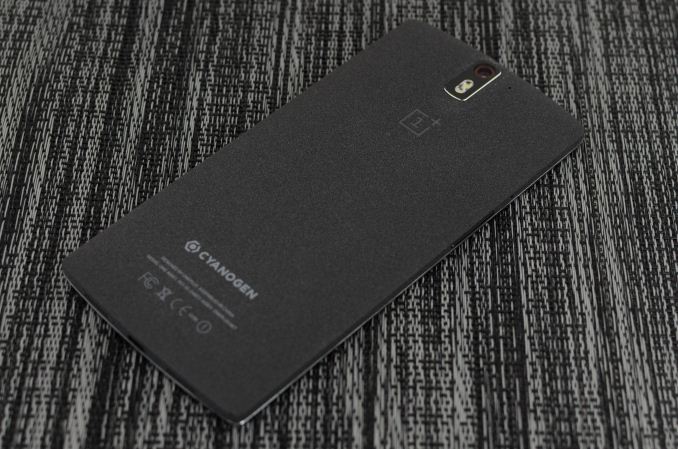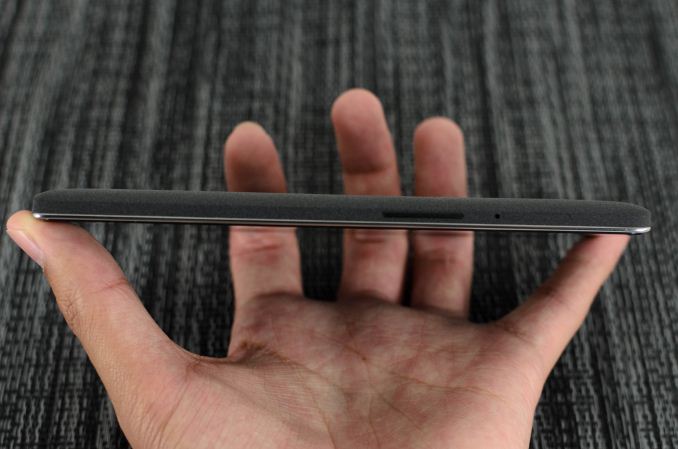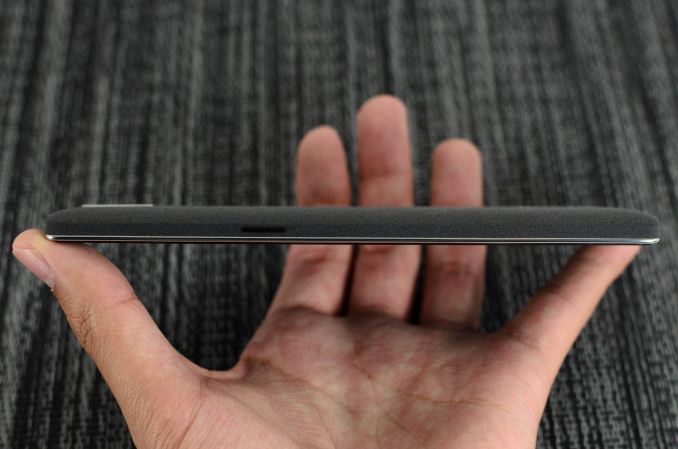The OnePlus One Review
by Joshua Ho on November 19, 2014 8:00 AM EST- Posted in
- Smartphones
- Android
- Mobile
- OnePlus

The OnePlus One has been one of the most hyped smartphones of 2014. There's really not much else to be said, as OnePlus' marketing has been quite noticeable amongst Android enthusiasts. The OnePlus One seems to come from nowhere, although there is a noticeable resemblance to the Oppo Find 7A which is produced in the same factory. The OnePlus One is said to be a flagship killer, as its high-end specs come with a mid-range price. The 16GB version starts at 299 USD and the 64GB version starts at 349 USD. With a 5.5" 1080p display, Snapdragon 801 SoC, and plenty of other bits and pieces to go around, the specs are certainly enough to make it into a flagship phone. Of course, the real question is whether it really is. After all, while specs provide the foundation, what makes a phone bad, good, or great has to do with the entire phone, not just the spec sheet. At any rate, I've attached this spec sheet below to give an idea of what to expect from the phone.
| Oppo Find 7a | OnePlus One | |
| SoC | MSM8974ABv3 2.3 GHz Snapdragon 801 |
MSM8974ACv3 2.45 GHz Snapdragon 801 |
| RAM/NAND | 2 GB LPDDR3, 16GB NAND + microSD | 3GB LPDDR3, 16/64GB NAND |
| Display | 5.5” 1080p IPS LCD (JDI) | 5.5” 1080p IPS LCD (JDI) |
| Network | 2G / 3G / 4G LTE (Qualcomm MDM9x25 UE Category 4 LTE) | 2G / 3G / 4G LTE (Qualcomm MDM9x25 UE Category 4 LTE) |
| Dimensions | 152.6 x 75 x 9.2 mm, 170 grams | 152.9 x 75.9 x 8.9 mm, 162 grams |
| Camera | 13MP (4128 x 3096) Rear Facing, 1/3.06" CMOS size (Sony IMX214), F/2.0, 5MP FFC w/ F/2.0 aperture | 13MP (4128 x 3096) Rear Facing, 1/3.06" CMOS size (Sony IMX214), F/2.0, 5MP FFC w/ F/2.0 aperture |
| Battery | 2800 mAh (10.64 Whr) | 3100 mAh (11.78 Whr) |
| OS | Android 4.3 with ColorOS | Android 4.4.4 with CyanogenMod 11S |
| Connectivity | 802.11a/b/g/n/ac + BT 4.0, USB2.0, GPS/GNSS, DLNA, NFC | 802.11a/b/g/n/ac + BT 4.0, USB2.0, GPS/GNSS, DLNA, NFC |
| SIM Size | MicroSIM | MicroSIM |
Needless to say, the OnePlus One is a close cousin of the Find 7a, and its specs are top notch. There's a great foundation, so we'll move on with some initial hardware impressions.
Of course, the first part to look at is industrial and material design, along with any other immediate observations about the phone. From the front, the phone is almost a pure expanse of black glass. There are outlines for the capacitive keys, but these are quite faint most of the time. The contrast of the silver plastic ring only emphasizes this, and the lack of logos helps to make the design stand out by virtue of its minimalism. Picking it up, the feel of the sandstone black finish is incredibly unique and unlike anything I've ever felt. The finish has been described as soft sandpaper, and that's a description I'd agree with. It makes the phone feel much grippier than one might expect. The back cover is also strong, with no real give and no flex. Other than a few logos, the only significant design elements on the back are the camera, dual LED flash, and a hole for the microphone. The front of the phone has surprisingly great attention to detail as well. The silver plastic piece on the front of the phone makes the finger smoothly roll off of the display when swiping around, and the imperceptible feel of the earpiece helps to contribute to the sense that this is a single, well-built phone.
On the sides, the minimalistic theme continues. There's only a power button on the right side, a headphone jack and microphone port on the top, and a volume rocker on the left side. The SIM tray is also on the left side, and on the bottom of the phone we see two speakers, a USB port, and a microphone hole. In general, the feel of the power and volume buttons are great, with no slack and a clean, if subdued click upon activation.
Needless to say, OnePlus has done a fantastic job. However, there are a few issues to talk about. First, the size is definitely too much to handle. If the LG G3 was at the very edge between a phone and phablet, the OnePlus One firmly steps into phablet territory. At some point a line in the sand has to be drawn, and it only makes sense to do so here. The angular corners of the OnePlus One combined with its larger footprint makes for a phone that is almost impossible to comfortably use with one hand. I can't help but feel that this would've been a far more impressive phone if shrunk to a 5" display size, as in my experience it takes two hands to comfortably use this phone. The other issue is much more subtle though. For some reason or another, the glass lens covering the display of the phone feels as if it has noticeably higher friction than other phones I've used. It almost feels as if the oleophobic treatment of the glass is either missing or thinner than most. Of course, overall the phone is great from a basic design perspective. The size seems to be a matter of OnePlus' start-up position and the need to share parts with the Find 7a, although the feel of the glass is unlikely to be an issue for most.













148 Comments
View All Comments
flyingpants1 - Wednesday, November 19, 2014 - link
It doesn't matter, since the screen takes most of the battery power. You have a point about the bezels, though.tipoo - Wednesday, November 19, 2014 - link
Yes, but the added area for the battery has consistently been shown to outweigh that con, ie larger phones are nearly always at the top of the battery life charts outside of outliers like super low power SoCs or huge thick batteries.srkelley - Thursday, November 20, 2014 - link
Honestly, the bezel sort of disappears while you're using this phone. I can definitely see how it would bother some people now, but in the end it can negligible if this is your sort of phone.Also, great review Joshua. I could not have done anything better myself here.
piroroadkill - Friday, November 21, 2014 - link
"but it couldn't have accommodated such a large battery with a smaller one."So there's no way I have a 4.7" phone with a 3300mAh battery then.. oh wait, I do..
DIYEyal - Monday, November 24, 2014 - link
I have a 5" phone with a 5000mAh battery.nevertell - Wednesday, November 19, 2014 - link
"While one can guess that an airplane is for airplane mode and a flashlight is for the torch, a circular arrow is utterly ambiguous in nature. Given the quick access nature of this menu, one might guess that this is a rotation lock toggle but for one reason or another it's actually the auto-sync toggle."Yes, but this is the same icon Google has used in their quick-settings-toggle widgets, with the only difference being that in this case, the quick settings ribbon is accessible in the drop down notifications shade instead on a homsecreen. Whilst it may be hard to understand the meaning of this icon, it is not like the same icon isn't used on most other devices to represent google's autosync.
JoshHo - Wednesday, November 19, 2014 - link
The issue is that this icon is given without any text to explain what it really is. It can be obvious to some but confusing to a lot of people.metayoshi - Wednesday, November 19, 2014 - link
I don't think the Auto Sync circle-arrow has actually been in the quick settings in any official Google ROM, correct me if I'm wrong, so I feel like CM and the rest of the AOSP community may have came up with it themselves. From what I remember, you have, User, Brightness, settings, WiFi, Bluetooth, Battery, Airplane Mode, Auto Rotate, and recently, Cast Screen. Android 5.0 finally added a flashlight officially. No Auto Sync mode.metayoshi - Wednesday, November 19, 2014 - link
Correction to my post: Auto Rotate was only on Tablets. The Auto Rotate quick setting was replaced by Mobile Data on Phones.tipoo - Wednesday, November 19, 2014 - link
Why does the Oneplus One set a record for final run score in the degradation test, when the 6, 6 plus, and HTC One are above it? Or is that including how long it runs relative to those?